 Facebook
Facebook
 X
X
 Instagram
Instagram
 TikTok
TikTok
 Youtube
Youtube
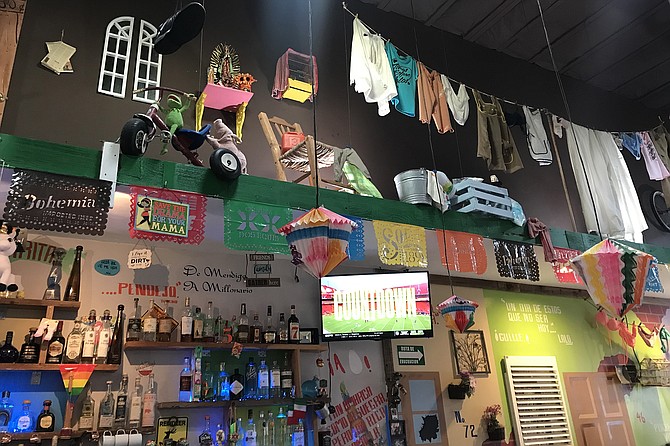
It’s the colors, here in this neighborhood that’s celebrating with tacos and beer and lots of noise, half a block from 5th and University. “Escandalo!”, a gal’s singing again and again. It looks like a scene from West Side Story.
This all started the other night when I was coming out of Hiro Nori (see Tin Fork 10/28/21), and noticed this hopping location. People joking, drinking, eating, groups huddling around brightly-covered campground tables, kids stretching their jaws around messy tacos. The walls were scattered with signs like “Tacos Before Vatos” and “The Short Man is the Happy Man,” plus plenty more, hand-painted on the walls in Spanish. Along with the music, thee were great Day of the Dead decorations: beautiful women’s faces painted like skulls with orange eye sockets, an older couple smiling out from real photos in the paintings. Ruperto and Lupita. Must be the parents of the owners.
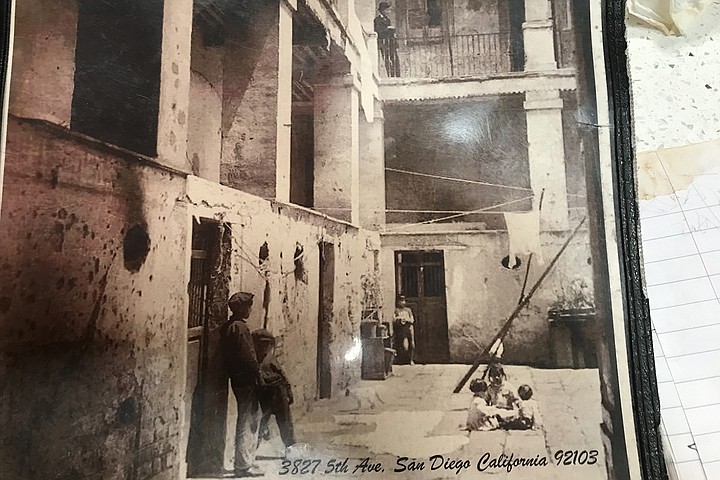
“No, grandparents,” says Antonio, who is working at the bar when I pay the place a proper visit. “Our parents were Lalo and Guille.” Family is the backbone of this place. Antonio and his brothers Javier and Ignacio (Nacho) run it. “Our food resembles puestos (food stands), from the streets of Mexico City,” he says. It has atmosphere, that’s for sure, as well as all this joyful noise going on. And, now I look, washing hung out to dry across upper balconies. I’m in some old Mexican City neighborhood!
It’s early in the day. Too early for happy hour, turns out. That’s 3-7 daily. Right now, it’s only two. But they have lots of non-HH deals, from $5 cups of corn to a bowl of chicken (or steak), along with black beans, queso fresco, salad and rice, for $12. But seems to me this place is really a living tribute to some of the greatest taco-makers ever, the Aztecs, who ruled Tenochtitlan (Mexico City) and a big chunk of Central America till 1521. (Hernan Cortez, anybody?) So natch, I concentrate on La Vecindad’s generous taco section.
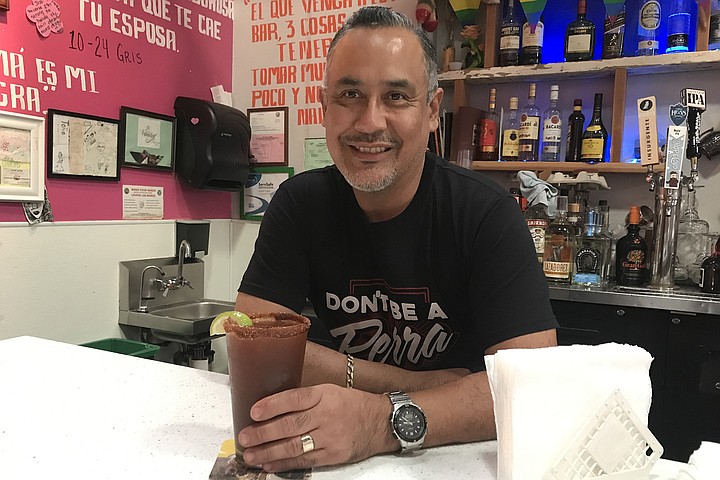
For starters, they use only homemade corn tortillas. Big plus in my book. And their tacos are all the same price, $4.25 ($3 in HH). Another good thing, because this way, you’re free to choose what you need, not what you can or cannot afford. Also, they promise to use only certified Angus beef. And I’m glad to see they’ve got cochinita pibil, beef tenderized with achiote and orange juice.
The Costa Azul taco looks good, with bacon-wrapped shrimp, red cabbage, sliced avo, chipotle, aioli, and queso fresco. El Perron (“The Dog?”) has steak seasoned “Mexico City style” with nopales, onions and potatoes; and the Lalo uses homemade longaniza sausage created by Antonio’s dad. But I end up choosing the campechano taco, because it has that same seasoned steak, but also includes the longaniza sausage, plus onions, nopales and potatoes. Rico suave! (Yet it’s named for the coastal state of Campeche, which is known for its seafood. Go figure.)
They have plenty of vegetarian tacos too, like the beet taco, which is pan-seared beets with interesting sides like jicama, pineapple, and berry sauce. And also, interesting seafood tacos like this new one they have called Crazy Pulpo, which has octopus marinated in a soy-mustard sauce, plus melted cheese and black beans. Sounds worth trying just because they serve it in an organic tortilla made of beets. It does cost $6, though.

But heavens. They all look interesting. Hmm. I order up a cup of sopa Azteca ($6), a tomato-based soup with white jicama chunks, fried black ribbons of zippy guajillo peppers, and lots of corn tortilla strips which kind of define the taste. And, have to say, the campechano taco and its steak meat really are tasty and tender, and the nopal strips and sautéed spuds are good, too.
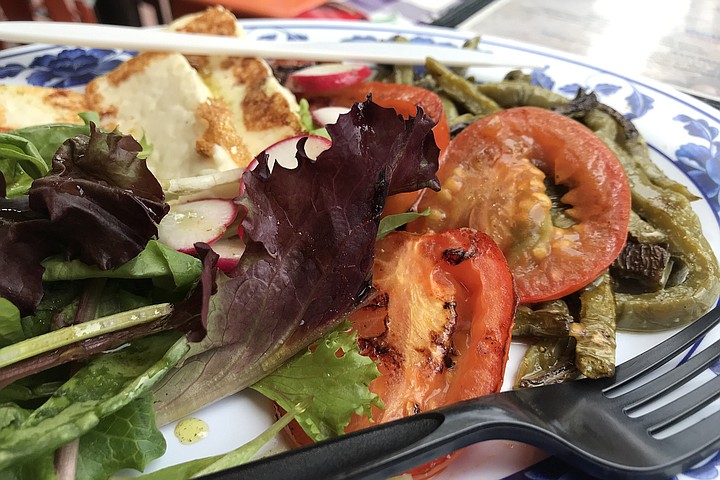
“Our family, the Fragoso family, started this place six years ago,” says Antonio. “We came up from Mexico City. We all designed the menu together. My mom had had two restaurants down there. Unfortunately, she passed away before this restaurant really took off.” He’s making up a michelada, with the usual lime, black pepper, Clamato, whatever. But this one is brown and grainy. Costs $12.
“Do you know the story about vecindad?” says Antonio. I’m guessing it’s about “neighborhood,” but he says it’s more. “Vecindades especially were created in Mexico City when the old rich families moved out of their inner city mansions for more modern housing. The poor moved in and divided up the big houses, useing shared facilities around a courtyard. Called them vecindades. They became popular as ways to accommodate the poor.” Now, vecindades are a model that modern urban planners in the places like the US are looking to in their effort to help with the current housing crisis.
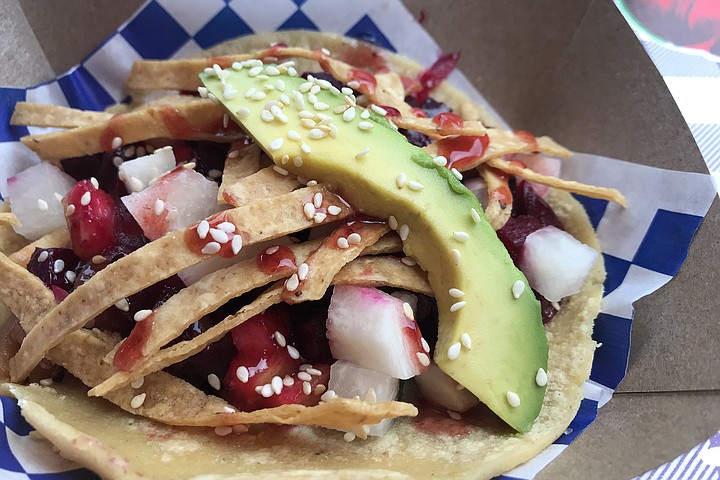
And guess what? Next day, I’m back. Because yesterday, I eyed two things I really liked the look of, the beet taco (that’s beet, not beef) where beet is the “meat” of the taco, and the non-taco queso asado — basically slabs of seared cheese, plus nopales, and grilled tomatoes “smothered in epazote herb and olive oil.”
The thing is, they’re served with nice, hot, and spectacularly blue-black corn tortillas. Cost $10. It’s good as a starter, and an introduction to the beet taco, which has tortilla strips, jicama, avo, and sweet jam to sex up those maroon chunks. It’s almost like a dessert, and a nice ending to this little safari to “Mexico City.” Next time, though, I’m gonna chase the deals on Taco Tuesday.


It’s the colors, here in this neighborhood that’s celebrating with tacos and beer and lots of noise, half a block from 5th and University. “Escandalo!”, a gal’s singing again and again. It looks like a scene from West Side Story.
This all started the other night when I was coming out of Hiro Nori (see Tin Fork 10/28/21), and noticed this hopping location. People joking, drinking, eating, groups huddling around brightly-covered campground tables, kids stretching their jaws around messy tacos. The walls were scattered with signs like “Tacos Before Vatos” and “The Short Man is the Happy Man,” plus plenty more, hand-painted on the walls in Spanish. Along with the music, thee were great Day of the Dead decorations: beautiful women’s faces painted like skulls with orange eye sockets, an older couple smiling out from real photos in the paintings. Ruperto and Lupita. Must be the parents of the owners.

“No, grandparents,” says Antonio, who is working at the bar when I pay the place a proper visit. “Our parents were Lalo and Guille.” Family is the backbone of this place. Antonio and his brothers Javier and Ignacio (Nacho) run it. “Our food resembles puestos (food stands), from the streets of Mexico City,” he says. It has atmosphere, that’s for sure, as well as all this joyful noise going on. And, now I look, washing hung out to dry across upper balconies. I’m in some old Mexican City neighborhood!
It’s early in the day. Too early for happy hour, turns out. That’s 3-7 daily. Right now, it’s only two. But they have lots of non-HH deals, from $5 cups of corn to a bowl of chicken (or steak), along with black beans, queso fresco, salad and rice, for $12. But seems to me this place is really a living tribute to some of the greatest taco-makers ever, the Aztecs, who ruled Tenochtitlan (Mexico City) and a big chunk of Central America till 1521. (Hernan Cortez, anybody?) So natch, I concentrate on La Vecindad’s generous taco section.

For starters, they use only homemade corn tortillas. Big plus in my book. And their tacos are all the same price, $4.25 ($3 in HH). Another good thing, because this way, you’re free to choose what you need, not what you can or cannot afford. Also, they promise to use only certified Angus beef. And I’m glad to see they’ve got cochinita pibil, beef tenderized with achiote and orange juice.
The Costa Azul taco looks good, with bacon-wrapped shrimp, red cabbage, sliced avo, chipotle, aioli, and queso fresco. El Perron (“The Dog?”) has steak seasoned “Mexico City style” with nopales, onions and potatoes; and the Lalo uses homemade longaniza sausage created by Antonio’s dad. But I end up choosing the campechano taco, because it has that same seasoned steak, but also includes the longaniza sausage, plus onions, nopales and potatoes. Rico suave! (Yet it’s named for the coastal state of Campeche, which is known for its seafood. Go figure.)
They have plenty of vegetarian tacos too, like the beet taco, which is pan-seared beets with interesting sides like jicama, pineapple, and berry sauce. And also, interesting seafood tacos like this new one they have called Crazy Pulpo, which has octopus marinated in a soy-mustard sauce, plus melted cheese and black beans. Sounds worth trying just because they serve it in an organic tortilla made of beets. It does cost $6, though.

But heavens. They all look interesting. Hmm. I order up a cup of sopa Azteca ($6), a tomato-based soup with white jicama chunks, fried black ribbons of zippy guajillo peppers, and lots of corn tortilla strips which kind of define the taste. And, have to say, the campechano taco and its steak meat really are tasty and tender, and the nopal strips and sautéed spuds are good, too.

“Our family, the Fragoso family, started this place six years ago,” says Antonio. “We came up from Mexico City. We all designed the menu together. My mom had had two restaurants down there. Unfortunately, she passed away before this restaurant really took off.” He’s making up a michelada, with the usual lime, black pepper, Clamato, whatever. But this one is brown and grainy. Costs $12.
“Do you know the story about vecindad?” says Antonio. I’m guessing it’s about “neighborhood,” but he says it’s more. “Vecindades especially were created in Mexico City when the old rich families moved out of their inner city mansions for more modern housing. The poor moved in and divided up the big houses, useing shared facilities around a courtyard. Called them vecindades. They became popular as ways to accommodate the poor.” Now, vecindades are a model that modern urban planners in the places like the US are looking to in their effort to help with the current housing crisis.

And guess what? Next day, I’m back. Because yesterday, I eyed two things I really liked the look of, the beet taco (that’s beet, not beef) where beet is the “meat” of the taco, and the non-taco queso asado — basically slabs of seared cheese, plus nopales, and grilled tomatoes “smothered in epazote herb and olive oil.”
The thing is, they’re served with nice, hot, and spectacularly blue-black corn tortillas. Cost $10. It’s good as a starter, and an introduction to the beet taco, which has tortilla strips, jicama, avo, and sweet jam to sex up those maroon chunks. It’s almost like a dessert, and a nice ending to this little safari to “Mexico City.” Next time, though, I’m gonna chase the deals on Taco Tuesday.